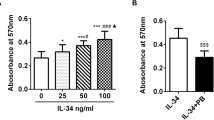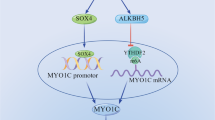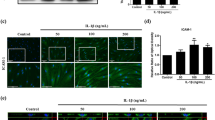Abstract
Urokinase-type plasminogen activator receptor (uPAR), is a multifunctional receptor on cell surface, widely present in endothelial cells, fibroblasts, and a variety of malignant cells. Current studies have suggested that uPAR overexpressed on synovial tissues or in synovial fluid or plasma in patients with rheumatoid arthritis (RA). However, there are limited researches regarding the role of uPAR on fibroblast-like synoviocytes of rheumatoid arthritis (RA-FLSs) and its underlying mechanisms. Here, our studies show that the expression of uPAR protein was significantly higher in fibroblast-like synoviocytes (FLSs) from RA than those from osteoarthritis or traumatic injury patients. uPAR gene silencing significantly inhibited RA-FLSs cell proliferation, restrained cell transformation from the G0/G1 phase to S phase, aggravated cell apoptosis, interfered with RA-FLSs cell migration and invasion, and reduced activation of the PI3K/Akt signaling pathway, which may be associated with β1-integrin. Cell supernatants from uPAR gene-silenced RA-FLSs markedly inhibited the migration and tubule formation ability of the HUVECs (a human endothelial cell line). Therefore, we demonstrate that uPAR changes the biological characteristics of RA-FLSs, and affects neoangiogenesis of synovial tissues in patients with RA. All of these may be associated with the β1-integrin/PI3K/Akt signaling pathway. These results imply that targeting uPAR and its downstream signal pathway may provide therapeutic effects in RA.
This is a preview of subscription content, access via your institution
Access options
Subscribe to this journal
Receive 12 digital issues and online access to articles
$119.00 per year
only $9.92 per issue
Buy this article
- Purchase on Springer Link
- Instant access to full article PDF
Prices may be subject to local taxes which are calculated during checkout






Similar content being viewed by others
References
Henry J, Roulot E, Gaujoux-Viala C . The rheumatoid hand. Presse Med 2013; 42: 1607–1615.
Bartok B, Firestein GS . Fibroblast-like synoviocytes: key effector cells in rheumatoid arthritis. Immunol Rev 2010; 233: 233–255.
Huber LC, Distler O, Tarner I, Gay RE, Gay S, Pap T . Synovial fibroblasts: key players in rheumatoid arthritis. Rheumatology 2006; 45: 669–675.
Rao JS, Gujrati M, Chetty C . Tumor-associated soluble uPAR-directed endothelial cell motility and tumor angiogenesis. Oncogenesis 2013; 2: e53.
Shetty S, Kumar A, Johnson AR, Pueblitz S, Holiday D, Raghu G et al. Differential expression of the urokinase receptor in fibroblasts from normal and fibrotic human lungs. Am J Respir Cell Mol Biol 1996; 15: 78–87.
Postiglione L, Montuori N, Riccio A, Di Spigna G, Salzano S, Rossi G et al. The plasminogen activator system in fibroblasts from systemic sclerosis. Int J Immunopathol Pharmacol 2010; 23: 891–900.
Alpizar-Alpizar W, Nielsen BS, Sierra R, Illemann M, Ramirez JA, Arias A et al. Urokinase plasminogen activator receptor is expressed in invasive cells in gastric carcinomas from high- and low-risk countries. Int J Cancer J Int Cancer 2010; 126: 405–415.
Nielsen BS, Rank F, Illemann M, Lund LR, Dano K . Stromal cells associated with early invasive foci in human mammary ductal carcinoma in situ coexpress urokinase and urokinase receptor. Int J Cancer J Int Cancer 2007; 120: 2086–2095.
Ulisse S, Baldini E, Sorrenti S, D’Armiento M . The urokinase plasminogen activator system: a target for anti-cancer therapy. Curr Cancer Drug Targets 2009; 9: 32–71.
Smith HW, Marshall CJ . Regulation of cell signalling by uPAR. Nat Rev Mol Cell Biol 2010; 11: 23–36.
Alfano D, Franco P, Vocca I, Gambi N, Pisa V, Mancini A et al. The urokinase plasminogen activator and its receptor: role in cell growth and apoptosis. Thromb Haemost 2005; 93: 205–211.
Slot O, Brunner N, Locht H, Oxholm P, Stephens RW . Soluble urokinase plasminogen activator receptor in plasma of patients with inflammatory rheumatic disorders: increased concentrations in rheumatoid arthritis. Ann Rheum Dis 1999; 58: 488–492.
Guiducci S, Del Rosso A, Cinelli M, Margheri F, D’Alessio S, Fibbi G et al. Rheumatoid synovial fibroblasts constitutively express the fibrinolytic pattern of invasive tumor-like cells. Clin Exp Rheumatol 2005; 23: 364–372.
Arnett FC, Edworthy SM, Bloch DA, McShane DJ, Fries JF, Cooper NS et al. The American Rheumatism Association 1987 revised criteria for the classification of rheumatoid arthritis. Arthritis Rheum 1988; 31: 315–324.
Hochberg MC, Altman RD, Brandt KD, Clark BM, Dieppe PA, Griffin MR et al. Guidelines for the medical management of osteoarthritis. Part II. Osteoarthritis of the knee. American College of Rheumatology. Arthritis Rheum 1995; 38: 1541–1546.
Nowicki TS, Zhao H, Darzynkiewicz Z, Moscatello A, Shin E, Schantz S et al. Downregulation of uPAR inhibits migration, invasion, proliferation, FAK/PI3K/Akt signaling and induces senescence in papillary thyroid carcinoma cells. Cell Cycle 2011; 10: 100–107.
Szekanecz Z, Koch AE . Targeting angiogenesis in rheumatoid arthritis. Curr Rheumatolo Rev 2008; 4: 298–303.
Stephens RW, Pollanen J, Tapiovaara H, Leung KC, Sim PS, Salonen EM et al. Activation of pro-urokinase and plasminogen on human sarcoma cells: a proteolytic system with surface-bound reactants. J Cell Biol 1989; 108: 1987–1995.
Ferraris GM, Sidenius N . Urokinase plasminogen activator receptor: a functional integrator of extracellular proteolysis, cell adhesion, and signal transduction. Sem Thromb Hemost 2013; 39: 347–355.
Noh H, Hong S, Huang S . Role of urokinase receptor in tumor progression and development. Theranostics 2013; 3: 487–495.
Tang CH, Hill ML, Brumwell AN, Chapman HA, Wei Y . Signaling through urokinase and urokinase receptor in lung cancer cells requires interactions with beta1 integrins. J Cell Sci 2008; 121: 3747–3756.
Nalla AK, Gorantla B, Gondi CS, Lakka SS, Rao JS . Targeting MMP-9, uPAR, and cathepsin B inhibits invasion, migration and activates apoptosis in prostate cancer cells. Cancer Gene Ther 2010; 17: 599–613.
Malla R, Gopinath S, Alapati K, Gondi CS, Gujrati M, Dinh DH et al. Downregulation of uPAR and cathepsin B induces apoptosis via regulation of Bcl-2 and Bax and inhibition of the PI3K/Akt pathway in gliomas. PLoS One 2010; 5: e13731.
Liu G, Yang Y, Yang S, Banerjee S, De Freitas A, Friggeri A et al. The receptor for urokinase regulates TLR2 mediated inflammatory responses in neutrophils. PLoS One 2011; 6: e25843.
Serrati S, Margheri F, Chilla A, Neumann E, Muller-Ladner U, Benucci M et al. Reduction of in vitro invasion and in vivo cartilage degradation in a SCID mouse model by loss of function of the fibrinolytic system of rheumatoid arthritis synovial fibroblasts. Arthritis Rheum 2011; 63: 2584–2594.
Firestein GS . Evolving concepts of rheumatoid arthritis. Nature 2003; 423: 356–361.
Xu C, Sun G, Yuan G, Wang R, Sun X . Effects of platycodin D on proliferation, apoptosis and PI3K/Akt signal pathway of human glioma U251 cells. Molecules 2014; 19: 21411–21423.
Wang W, Wang C, Jiang Y, Wu B . Effect of miR-92b on migration, adhesion and invasion of human gastric cancer cell line SGC7901. Nan Fang Yi Ke Da Xue Xue Bao 2014; 34: 1748–1752.
Yoo SA, Kwok SK, Kim WU . Proinflammatory role of vascular endothelial growth factor in the pathogenesis of rheumatoid arthritis: prospects for therapeutic intervention. Mediators Inflamm 2008; 2008: 129873.
Paleolog EM . The vasculature in rheumatoid arthritis: cause or consequence? Int J Exp Pathol 2009; 90: 249–261.
Acknowledgements
This work was supported in part by the grants from Science and Technology Planning Project of Guangdong Province, China (2012B031800363); Science and Technology Program of Guangzhou, China (Special Project on the Integration of Industry, Education and Research); Developing Program of the Major Research Plan of the National Natural Science Foundation of Guangdong, China (2014A030308005); National Natural Science Foundation of China (81671611); and Major National developing program of the national level in Higher Education of Guangdong, China (Natural Science).
Author information
Authors and Affiliations
Corresponding authors
Ethics declarations
Competing interests
The authors declare no conflict of interest.
Additional information
Supplementary Information for this article can be found on the Cellular & Molecular Immunology website
Supplementary information
Rights and permissions
About this article
Cite this article
Liu, Y., Pan, Y., Xue, Yq. et al. uPAR promotes tumor-like biologic behaviors of fibroblast-like synoviocytes through PI3K/Akt signaling pathway in patients with rheumatoid arthritis. Cell Mol Immunol 15, 171–181 (2018). https://doi.org/10.1038/cmi.2016.60
Received:
Revised:
Accepted:
Published:
Issue Date:
DOI: https://doi.org/10.1038/cmi.2016.60
Keywords
This article is cited by
-
Simeprevir restores the anti-Staphylococcus activity of polymyxins
AMB Express (2023)
-
YY1 regulates the proliferation and invasion of triple-negative breast cancer via activating PLAUR
Functional & Integrative Genomics (2023)
-
Inhibition of Cdc37 Ameliorates Arthritis in Collagen-Induced Arthritis Rats by Inhibiting Synoviocyte Proliferation and Migration Through the ERK Pathway
Inflammation (2023)
-
PLAUR splicing pattern in hereditary angioedema patients’ monocytes and macrophages
Molecular Biology Reports (2023)
-
Rheumatoid arthritis fibroblast-like synoviocytes maintain tumor-like biological characteristics through ciRS-7-dependent regulation of miR-7
Molecular Biology Reports (2022)



